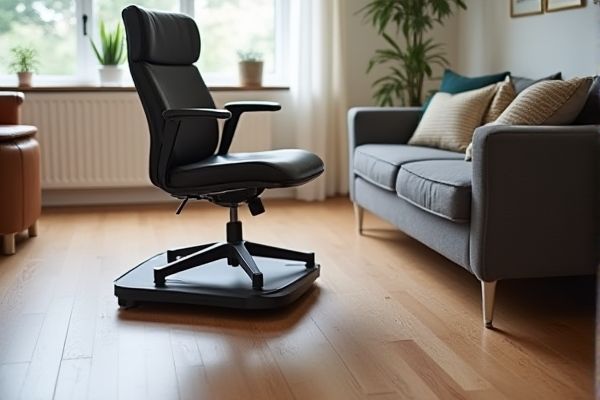
An ergonomic footrest is designed to provide optimal support and promote better posture by encouraging proper leg and back alignment, whereas a standard footrest typically offers only basic elevation without specific ergonomic benefits. Discover how choosing the right footrest can enhance your comfort and productivity by reading the rest of the article.
Table of Comparison
| Feature | Ergonomic Footrest | Standard Footrest |
|---|---|---|
| Design | Contoured for natural foot positioning | Flat, basic platform |
| Adjustability | Height and angle adjustable | Fixed height and angle |
| Material | Non-slip surface with cushioning | Simple plastic or wood |
| Comfort | Promotes improved posture and circulation | Minimal comfort support |
| Health Benefits | Reduces lower back pain and fatigue | No specific ergonomic benefits |
| Price | Higher cost due to ergonomic features | Lower cost |
| Usage | Ideal for prolonged desk work | Suitable for occasional use |
Introduction to Footrests: Ergonomic vs. Standard
Ergonomic footrests are designed to support your feet at optimal angles, promoting better posture and reducing strain on your lower back and legs. Standard footrests typically offer basic elevation without adjustable features, which may not provide sufficient comfort or alignment for extended use. Choosing an ergonomic footrest can enhance circulation and reduce fatigue, making it a superior option for long hours at a desk.
Key Differences Between Ergonomic and Standard Footrests
Ergonomic footrests are designed to provide adjustable height, tilt, and support that promotes proper posture and reduces strain on your lower back and legs, unlike standard footrests which typically offer fixed, non-adjustable surfaces. Key differences include enhanced cushioning and material quality in ergonomic models that improve comfort during prolonged use, whereas standard footrests often prioritize basic functionality over comfort. Choosing an ergonomic footrest can significantly enhance your workspace by improving circulation and reducing discomfort compared to traditional, non-adjustable footrests.
Health Benefits of Ergonomic Footrests
Ergonomic footrests provide superior health benefits compared to standard footrests by promoting proper posture, reducing lower back strain, and enhancing circulation in the legs and feet. These footrests feature adjustable height and tilt options, allowing users to customize support to their body's unique alignment needs, which decreases the risk of musculoskeletal disorders. Studies show that consistent use of ergonomic footrests can minimize discomfort associated with prolonged sitting, improving overall workplace wellness and productivity.
Common Features of Standard Footrests
Standard footrests typically feature adjustable height and tilt settings to improve comfort and promote better posture during seated work. They often have a non-slip surface to keep your feet stable and reduce strain on your legs and lower back. Commonly made from durable plastic or lightweight materials, these footrests provide basic support but lack the advanced design elements found in ergonomic models.
Impact on Posture and Comfort
Ergonomic footrests are designed to promote optimal posture by supporting the natural alignment of the feet, ankles, and legs, reducing strain on the lower back and improving circulation. Unlike standard footrests, ergonomic models often feature adjustable height and tilt options that accommodate individual body dimensions, enhancing overall comfort during prolonged sitting. This targeted support can alleviate pressure points and prevent musculoskeletal discomfort associated with poor posture.
Adjustability and Customization Options
Ergonomic footrests offer superior adjustability and customization options compared to standard footrests, featuring adjustable height, tilt, and sometimes even massage surfaces that adapt to your specific posture needs. Standard footrests typically provide fixed or limited adjustability, which may not adequately support optimal ergonomic positioning. Investing in an ergonomic footrest ensures your legs and feet maintain proper alignment, reducing strain and enhancing comfort during prolonged sitting.
Material and Build Quality Comparison
Ergonomic footrests typically feature high-quality materials such as memory foam, durable plastics, and steel frames designed to provide superior comfort and support, reducing strain during prolonged use. Standard footrests often use basic plastic or lightweight metal, lacking the advanced cushioning and structural reinforcement found in ergonomic models. The enhanced build quality of ergonomic footrests ensures greater durability and improved user posture compared to standard footrests.
Cost Effectiveness and Value for Money
Ergonomic footrests often provide superior cost effectiveness by enhancing comfort and reducing strain-related injuries, potentially lowering healthcare expenses and increasing productivity. While standard footrests are typically less expensive upfront, they may lack adjustable features that support proper posture, leading to decreased long-term value. Investing in an ergonomic footrest offers greater value for money through improved durability, customizable support, and enhanced user well-being.
User Experience and Satisfaction
Ergonomic footrests enhance user experience by providing adjustable height and angle options that promote proper posture, reducing strain on the lower back and legs compared to standard footrests. Users report higher satisfaction with ergonomic models due to improved comfort during extended sitting periods and decreased fatigue. Research indicates that ergonomic footrests contribute to better circulation and overall well-being, leading to increased productivity and reduced discomfort in sedentary work environments.
Choosing the Right Footrest for Your Needs
Ergonomic footrests provide adjustable height and angle settings to promote proper posture and reduce strain during prolonged sitting, unlike standard footrests which often lack customization features. Selecting an ergonomic footrest tailored to your desk height and body dimensions can enhance comfort and improve circulation. Consider factors such as material quality, stability, and ease of adjustment to find a footrest that aligns with your specific ergonomic requirements.
 homyna.com
homyna.com